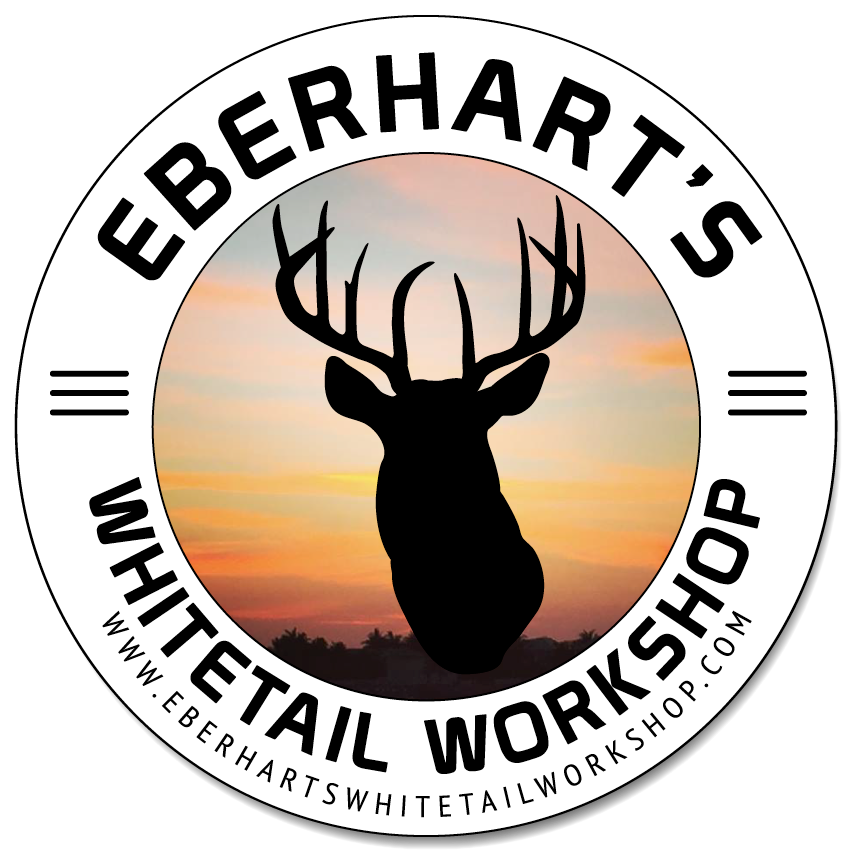TIPS from John Eberhart’s 40 plus years of saddle hunting and taking 44 book bucks from his 2-panel saddle from 32 different properties and 39 different trees.
Step placements
For trees 16-inch diameter and smaller place your ring of steps all at the same level (perpendicular to a straight trunk tree) and try to keep the steps equally spaced at about 8 to 10-inches apart so your feet can easily locate them without having to look down at them when moving around the tree,
For larger diameter trees keep the same 8 to 10-inch gaps between steps and use however many you need to ring the tree. On large trees, when you are putting steps on the backsides of the tree, raise them up about 1 ½ to 2-inches higher than the steps in front that you will be standing on during the hunt. When moving around a large tree, the tree tether rope will wrap and raise your body and you need the steps placed higher to accommodate it.
On leaning trees, it is very important to place the steps parallel to the ground (not perpendicular to the tree trunk) and raise each step on the backside of the tree 2 to 3 inches higher (depends on the lean of the tree). If the steps are placed too low on the backside of the tree, when you try to move to them, gravity will take over and pull you around and there will be nothing you can do about it. With the steps up higher on the backside, you will have the leverage to overcome gravities pull.
When using a platform, depending on the tree diameter and or lean, replicate the exact same procedure for placing additional steps on the backside of the tree as explained when using a full ring of steps. The platform is just a replacement for the front steps.
Ropeman and Kong cam adjustment buckles
If using 11mm lineman and tree tether ropes I suggest purchasing at least one Ropeman camlock adjustment buckle for your tree tether and if using 8mm ropes I suggest purchasing at least one Kong camlock adjustment buckle for your tree tether. The Ropeman and Kong adjusters can be adjusted immediately when needed whereas the prussic knots that come with the lineman and tree tether ropes will cinch to the ropes and have to be somewhat fidgeted with to get them to slide. If you can afford it, purchase one each for the lineman and tree tether ropes.
Tree tether hook-up height
I hook-up my tree tether at nose to eye height which creates a lower trajectory rope angle from the tree to the saddle which is more comfortable for the position I like to hunt in. With this hook-up the tether rope is also never in the way of my elbow when drawing my bow for any shots to my left.
Many YouTuber’s show a well above their head hook-up which creates a couple issues. The steep tether rope angle will put the rope much closer to your body causing it to be in the way of your elbow when drawing your bow for a shot anywhere to the left. The steep rope angle will also cause your upper body to lean back which will put more stress on your lower back. You can play with the tree tether height and use what is most comfortable for you and during a hunt you will be more comfortable if you can keep your upper body parallel to the tree or in a slightly leaning forward position.
Wearing a saddle on entries and exits
While many hunters wear their saddles during entries and exits, I keep mine saddle and ropes in my backpack and put it on at the base of the tree. During cold weather when I have my pack full of extra layering garments and have no extra room, I will wear my saddle along with my lineman rope during entries and exits.
Knee pads
Knee pads are also advised because sometimes your knees will be against the tree. For the first 20 years I hunted from a saddle I did not use knee pads and for the past 20 years I have, and I keep them in my backpack and put them on at the base of the tree before climbing.
Position to be perched in during a hunt
During a hunt I like to be perched midway between a sitting and standing position with my knees bent between 30 to 45 degrees. Saddles are designed to sit in, that is why they have a seat. So, if you don’t want your feet to be sore or your legs to get tired, don’t conform to the many YouTube video’s where hunters are in a standing position.
Seat depth during a hunt
During a hunt I like the outer panel to slightly overlap the inner panel or just be touching it so the seat is 10 to 12-inches in depth. For beginners I suggest adjusting the outer panel to make it a bit wider so they will feel more comfortable and safer sitting in a deeper 14 to 16-inch seat depth. As a hunter becomes more comfortable using a saddle, they can narrow the seat depth as desired and that is one of the many advantages of an ESS 2-panel saddle over a single panel where the seat depth can never be changed. Anytime you adjust the seat depth, only adjust the outer panel as the inner panel should ALWAYS be under your butt cheeks when hunting.
Body profile in a tree
When hunting I like to keep my body profile as tight to the tree as possible so that I don’t get picked and this is especially the case when the foliage is down during the rut phases and I have an open sky background. Remaining tight to or straddling the tree’s trunk is easier done when using a ring of steps where your legs can straddle the tree and be on steps on the sides of the tree.
When using any form of platform, you cannot straddle the tree and by standing on its front leading edge as many YouTuber’s do, your body is at least an additional 18-inches away from the tree trunk making getting picked a much higher probability, especially when the foliage is down and hunting in a heavily pressured area where deer look into tree for hunters.
Practicing from a tree
For getting used to the saddle set-up process and for practicing at targets, if you have an adequate tree or telephone pole in your yard, place a stick or step in the tree and then above it put in a ring of steps or a platform with additional steps on the backside of the tree. Once you step up onto the ring or platform, hook up everything else in the same manner as described for hunting.
When practicing, between groups of arrows move the target around to different positions so that you will get comfortable moving easily around the tree to shoot in all directions. If moving around the tree requires too much rigid movement and effort, add another step to the ring and shorten the gap between all of them on the ring. If it is easy to move around the tree you may consider placing the steps farther apart. Once you find your comfort gap, you will know how to prepare your ring or additional steps when using a platform, going forward.

